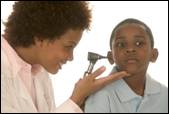
Development: Normal and Disordered
A Chapter in Core Concepts of Pediatrics, 2nd Edition
Virginia Niebuhr PhD

Pediatricians are health educators, developmental monitors, and counselors. Pediatricians will tell you that two of the most enjoyable parts of their work are the opportunity to see well children, not just sick ones, and the joy of seeing children and families over time as the children and the families grow and develop. In this chapter, readers can review the major roles of the pediatrician relevant to screening, assessment, and intervention about development.
 "How old is this child?" is one of the first questions to be asked about every pediatric patient. When presenting a pediatric case verbally or in a clinic note, always give the name, age and gender (e.g. "Kim is a 30-month old boy ...")
"How old is this child?" is one of the first questions to be asked about every pediatric patient. When presenting a pediatric case verbally or in a clinic note, always give the name, age and gender (e.g. "Kim is a 30-month old boy ...")
For children under three, age is measured in months, not years; but even for children three to five, it is important to know if they are a "young 3" or an "older 3", for there is considerable amount of development occurring even within the year.
Consider full-term to be 40 weeks. For premature infants (born before 37 weeks gestation), it is necessary to adjust their age when assessing development. Age correction for prematurity should be done for one year for moderate degrees of prematurity, but may be appropriate for up to two years for severe prematurity (i.e. born at less than 30 weeks gestation).
Example: For infant born at 34 weeks, correct with a factor of 6 weeks. Thus, at 6 months after birth (i.e. 24 weeks), the corrected age is 18 weeks, or 4 1/2 months. At 12 months (48 weeks), the corrected age is 42 weeks (or 10 1/2 months).

Pediatricians have many roles related to patients' development. These roles exist across the developmental age span - for infants, children and adolescents. We will review five roles:
Parents are not always aware of how their child should be developing or what behaviors and skills are appropriate for certain ages. The pediatrician becomes an educator. The direct teaching you can do at the well-child visit is important. But other creative "teaching" strategies can include involving nursing staff in developmental education, using the waiting room as a learning resource area, and providing parents information on appropriate resources such as pamphlets, book titles, videos, and websites. At each well-child visit, the pediatrician and the parent should review expected development for that age. In addition, there should be some discussion of the next stage of development to prepare the parent and the child or adolescent for future changes. This is called "anticipatory guidance."

It is important to determine if the child is meeting developmental expectations. Developmental surveillance (i.e. screening or monitoring) should be a part of every well-child visit, regardless of age. Role 2 allows also for engaging in Role 1, as your questions serve not only to assess the child's development, but also serve to educate the parent about what the child should be doing.
Go here for an example
The more you see children of different ages, the more you will learn about the expected development at different ages. After you see hundreds of 15-month olds, you will spot the 15-month who is not walking. After talking to hundreds of four-year olds, and recognizing the complexity of four-year old language, you will be concerned about a four-year old whose language you cannot understand well and who is only using 2-3 word sentences. But as a medical student, before you have an opportunity to see very many children, how will you know if development is appropriate? Learning how to ask the right questions and learning to use developmental screening tools will help you to better evaluate if the child is developing as expected for age.
The American Academy of Pediatrics' Policy on Developmental Surveillance and Screening (2006) recommend that developmental surveillance be incorporated at every well-child preventive care visit, then concerns be addressed with standardized screening .In addition, standardized screening should be conducted, at minimum, at the 9-, 18-, 30-month well child visits
Once you learn the questions to ask, your interview can yield rich information about development. Try to avoid questions that can be answered with 'yes/no' or 'fine.' Go here for an example
Many practices have designed their note templates (paper or electronic) in such a form that triggers you to ask about critical items.
In addition to the interview, there are formal developmental screening tools available for use in pediatric practices. The most common of these are the following:
Parents' Evaluation of Developmental Status, Ages and Stages Questionnaires, and Child Development Inventories,
Early Language Milestone Scale, and Brigance Screens
For links to these tools, see again the AAP policy on developmental surveillance and screening. mentioned above
It is important to consider all the major domains of development and screen in each area:
It is very hard to memorize developmental milestones. They often do not become meaningful until you see many children and have a sense of comparison. You don't want to inadvertently worry the parent by asking if the child is doing X, if X is way outside the range of normal. For example, you don't want to ask if the child can walk, if she is only six months old, or if she can tie her shoes if she is only three. As a student, it is best to refer to a developmental chart when asking questions associated with development.
 Just as with all the other types of medical screenings (e.g. mammography, vision screening, colorectal cancer screening), developmental screening, too, is interpreted as normal, abnormal, or inconclusive (re-screen). If a child is not meeting expected developmental milestones, it is important that the child receive a more comprehensive formalized assessment to determine the severity of the delay or deficit (i.e., at what age level is this child functioning?) and whether deficits also exist in other developmental domains.
Just as with all the other types of medical screenings (e.g. mammography, vision screening, colorectal cancer screening), developmental screening, too, is interpreted as normal, abnormal, or inconclusive (re-screen). If a child is not meeting expected developmental milestones, it is important that the child receive a more comprehensive formalized assessment to determine the severity of the delay or deficit (i.e., at what age level is this child functioning?) and whether deficits also exist in other developmental domains.
Comprehensive developmental assessment is available from a variety of sources, depending on the age of the child and on the community resources. If you become familiar with your community's resources, you can provide a family with a specific phone number to call or make a referral yourself.
Where can parents get formal developmental assessments?
Link here to information about special education laws.
Who conducts formal assessments?
Search for etiology. Consider reasons why this child's development might be delayed? However, it is important to recognize that (a) often, you will never know the etiology, and (b) you do not need to know the etiology before proceeding with referral for comprehensive developmental assessment and beginning a plan of intervention.

Pediatricians can advise families about strategies that can be used at home to foster development; but perhaps more importantly, pediatricians can help families access resources designed to help with developmental delays. Generally, comprehensive developmental assessment (see role #2 above), leads directly to intervention. Recommendations for intervention are given when the results of the assessment are explained to the family.
The sources for developmental interventions are the same as those listed above for assessment, with the addition of families-as-interventionists. Whereas a parent may not be able to assess development, the parent can intervene and apply appropriate guidance. Sometimes that guidance can come from the pediatrician, sometimes from a developmental specialist.
At one time or another, all parents have concerns about some of their child's behaviors. It is the pediatrician's role to help determine if this behavior is within the realm of normal (at the same time assisting with any necessary intervention) or if the problem signals a more serious disorder. A temper tantrum, "picky eating", or resistance to toilet training might be perceived by the parent as a problem, yet the pediatrician might recognize that the behavior is within the realm of "normal." The parents will often seek advice from the physician, and the physician is in a position to offer assistance through counseling. We refer to these as "normal behavior problems."
 Often parents do not have sufficient guidance on how to effectively discipline children. It is not always intuitive how to get children to follow directions or rules and how to teach them new skills. If parents do not have family members to teach them, are not connected with other parents, or do not seek reading materials on their own, they may be frustrated at how difficult it is to get their children to behave in expected ways.
Often parents do not have sufficient guidance on how to effectively discipline children. It is not always intuitive how to get children to follow directions or rules and how to teach them new skills. If parents do not have family members to teach them, are not connected with other parents, or do not seek reading materials on their own, they may be frustrated at how difficult it is to get their children to behave in expected ways.
The pediatrician can be of help in discussing effective discipline techniques. However, a common mistake is giving 1-2 minute advice at the end of a clinic session. If it were that easy, the parent would likely have already discovered this method. It may be more effective to set aside a separate visit with the family to discuss strategies to improve compliance with rules and following directions. Another strategy may be to provide reading material (handouts or references to books) for the parent to keep or read and return.
Some of the most important messages to give parents about disciplining their children are listed here:
 Common problems about which parents might seek the pediatrician's help include the following:
Common problems about which parents might seek the pediatrician's help include the following:
 Lack of expected development in one or more domains (motor, language and cognition, social or self-care) signals the likelihood of a developmental disorder. When behavior problems persist and significantly interfere with quality of individual or family life, they may signal the presence of a "disorder," especially a neurodevelopmental disorder or a mood disorder. It is not appropriate to refer to these as "behavior problems"; the "problems" are merely symptoms of something larger.
Lack of expected development in one or more domains (motor, language and cognition, social or self-care) signals the likelihood of a developmental disorder. When behavior problems persist and significantly interfere with quality of individual or family life, they may signal the presence of a "disorder," especially a neurodevelopmental disorder or a mood disorder. It is not appropriate to refer to these as "behavior problems"; the "problems" are merely symptoms of something larger.
Pediatricians are often the first to assess and identify neurodevelopmental and pediatric mood and anxiety disorders; and pediatricians are becoming increasingly involved in treatment or management of these disorders because psychiatric and psychological services are often less available and sometimes less likely to be covered by healthcare plans.
Below is a list of the most common diagnoses seen in children and adolescents, using categories from the Diagnostic and Statistical Manual of Mental Disorders (DSM)
| Category | Major examples |
|---|---|
| Attention Deficit Disorders | • ADHD combined Type • ADHD Inattentive Type- or ADD |
| Developmental Movement Disorders | • Cerebral palsy • Developmental Dyspraxia • Developmental Oral Apraxia |
| Language and Learning Disorders | • Expressive or Receptive Language Disorders • Articulation Disorders • Stuttering • Dyslexia (reading) • Dyscalculia (math) • Dysgraphia (writing) • Nonverbal Learning Disorder |
| Intellectual Disability | also called Global Developmental Disorder in very young children; and previously termed Mental Retardation; often associated with a genetic disorder. |
| Mood & Anxiety Disorders | • Mood: Dysthymia; Major Depression; Bipolar Disorder. • Anxiety: Phobias, Selective Mutism, Generalized Anxiety. • Obsessive-Compulsive Disorder |
| Autism Spectrum Disorder |

The interview to assess behavior problems and/or neurodevelopmental and mood disorders can take the same format as any other medical history-taking.
Adding the following questions will give you a good start on learning the family's perspective and expectation of the healthcare system?
Adding a thorough medical/developmental history will provide you clues to etiology of the problems. Find out about family history of neurodevelopmental disorders, and mood and anxiety disorders. Draw a genogram of the family to see who is related to whom and who lives in the family.
A thorough family history and genogram will provide three important sources of information:
Always begin with a broad differential. Do not limit yourself to your first impression. If you assume the child has ADHD because the parent says "he's so active" or if you assume the problems arise from the fact that the mother is only 20, you are very likely to miss some important contributing factors in your interview. Furthermore, realize that, more times than not, there will be co-morbidities and/or more than one diagnosis.

Sometimes pediatricians use the term "conduct disorder" to refer to poor conduct, such as not following directions and disrespect for authority; however the DSM defines conduct disorders as a set of behaviors severe enough to result in legal action. It is best to avoid use of the term unless the DSM criteria are strictly met and instead simply use the term "behavior problems."
The DSM provides specific criteria for this disorder, related to consistent poor response to authority. It is important to try to determine what factors underlie the oppositionality, as different etiologies suggest different interventions. Is the child oppositional because there is no attachment to the authority and thus no respect can develop? This suggests an attachment disorder, resulting from early physical and/or emotional separation. Does the oppositionality result from lack of clear directives or lack of consistent consequences for compliance or noncompliance? Does the oppositionality result from impulsivity associated with ADHD (the impulsive response from the child is "no") or from inattention associated with ADHD (the child did not hear the direction, so did not follow it)? Or does the oppositionality result from irritability or lethargy associated with a depressive disorder, or with the flight response associated with an anxiety disorder? It is the opinion of this author that an ODD diagnosis should always be secondary to a primary diagnosis which best defines the etiology.
In summary, the role of the pediatrician is very important for the identification of developmental disorders and behavioral/emotional disorders, and for educating families about normal development and common problems. Prepare yourself for each of the roles: